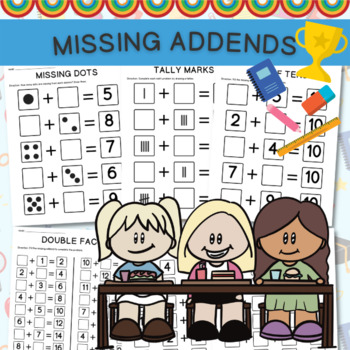Missing Addends l 1st Grade Math Practice Worksheet
HAPPY LEARNING HOME
49 Followers
Grade Levels
K - 2nd
Subjects
Resource Type
Standards
CCSS1.OA.A.1
CCSS1.OA.A.2
CCSS1.OA.B.4
CCSS1.OA.D.8
CCSSMP1
Formats Included
- PDF
- Easel Activity
Pages
20 pages
HAPPY LEARNING HOME
49 Followers
Easel Activity Included
This resource includes a ready-to-use interactive activity students can complete on any device. Easel by TPT is free to use! Learn more.
Description
If your students have been struggling with the problem-solving for a missing or unknown addend. Here are a perfect practice worksheet to your students to get more understandable.
The worksheet include:
20 pages for missing addends problems
- Missing Dots
- Tally Marks
- Sum of Tens
- Double Facts
- Trio Trouble
- Mini Game
TERMS OF USE
- For personal classroom or home education use.
- Every page of this resource is copyrighted. You may not recreate anything to sell or share based on this resource.
Thank you for considering or purchasing this product. I appreciate that you've spent (or considered spending) your hard-earned money on my resources. : D
Total Pages
20 pages
Answer Key
N/A
Teaching Duration
N/A
Report this resource to TPT
Reported resources will be reviewed by our team. Report this resource to let us know if this resource violates TPT’s content guidelines.
Standards
to see state-specific standards (only available in the US).
CCSS1.OA.A.1
Use addition and subtraction within 20 to solve word problems involving situations of adding to, taking from, putting together, taking apart, and comparing, with unknowns in all positions, e.g., by using objects, drawings, and equations with a symbol for the unknown number to represent the problem.
CCSS1.OA.A.2
Solve word problems that call for addition of three whole numbers whose sum is less than or equal to 20, e.g., by using objects, drawings, and equations with a symbol for the unknown number to represent the problem.
CCSS1.OA.B.4
Understand subtraction as an unknown-addend problem. For example, subtract 10 – 8 by finding the number that makes 10 when added to 8.
CCSS1.OA.D.8
Determine the unknown whole number in an addition or subtraction equation relating three whole numbers. For example, determine the unknown number that makes the equation true in each of the equations 8 + ? = 11, 5 = ▯ - 3, 6 + 6 = ▯.
CCSSMP1
Make sense of problems and persevere in solving them. Mathematically proficient students start by explaining to themselves the meaning of a problem and looking for entry points to its solution. They analyze givens, constraints, relationships, and goals. They make conjectures about the form and meaning of the solution and plan a solution pathway rather than simply jumping into a solution attempt. They consider analogous problems, and try special cases and simpler forms of the original problem in order to gain insight into its solution. They monitor and evaluate their progress and change course if necessary. Older students might, depending on the context of the problem, transform algebraic expressions or change the viewing window on their graphing calculator to get the information they need. Mathematically proficient students can explain correspondences between equations, verbal descriptions, tables, and graphs or draw diagrams of important features and relationships, graph data, and search for regularity or trends. Younger students might rely on using concrete objects or pictures to help conceptualize and solve a problem. Mathematically proficient students check their answers to problems using a different method, and they continually ask themselves, "Does this make sense?" They can understand the approaches of others to solving complex problems and identify correspondences between different approaches.






